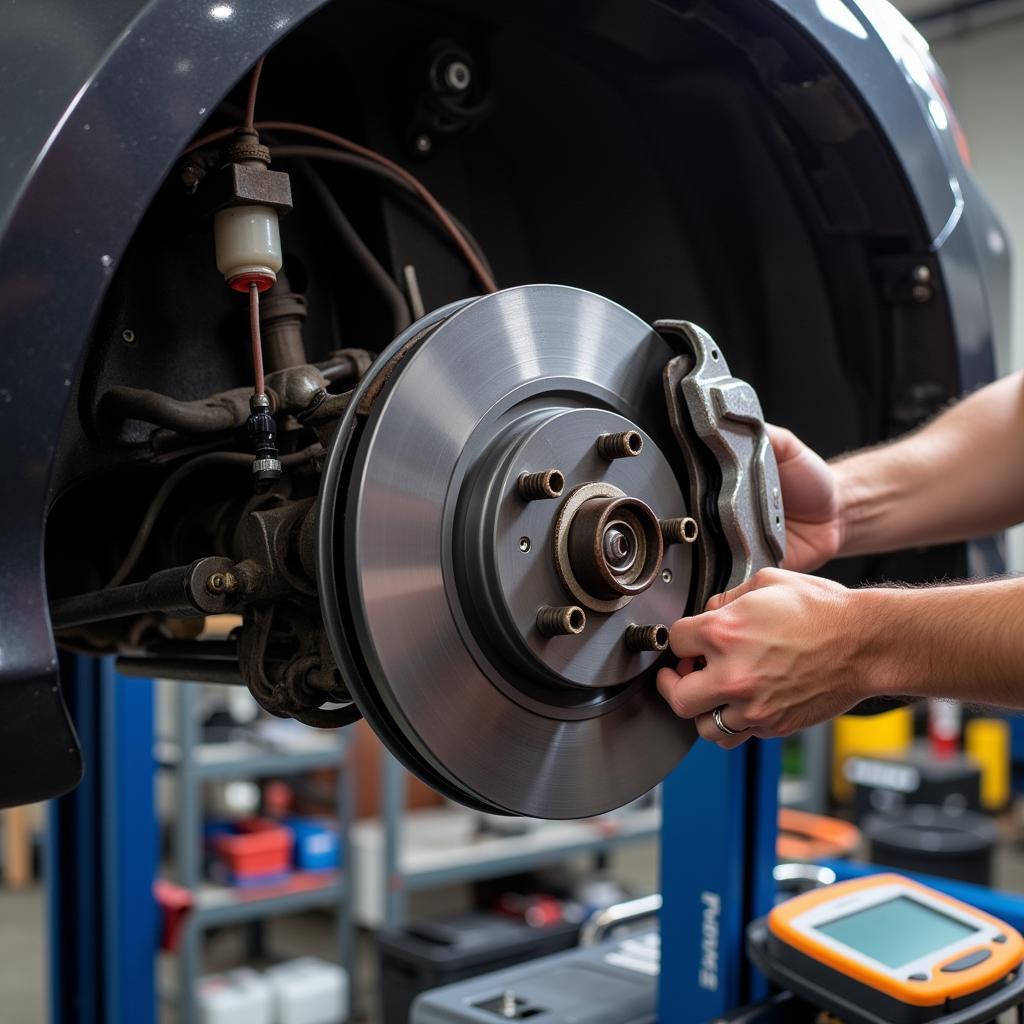The brake system warning light, a prominent fixture on your dashboard, illuminates for various reasons, not all of them critical. Understanding what triggers this warning light, and how to address it, is crucial for maintaining safe driving and vehicle longevity. This article delves into the common causes of a lit brake system warning light and provides guidance on diagnosis and solutions.
Decoding the Brake System Warning Light
The brake system warning light, often represented by an exclamation mark within a circle or the word “BRAKE,” serves as your car’s primary communication method for indicating issues within the braking system. When this light turns on, it signifies that one or more components require attention.
Common Culprits Behind a Lit Brake System Warning Light
Several factors can trigger the brake system warning light. Let’s explore some of the most prevalent causes:
- Low Brake Fluid Level: This is often the primary culprit. Brake fluid, responsible for transmitting force when you press the brake pedal, can decrease due to leaks in the system or worn brake pads.
- Activated Parking Brake: It might seem obvious, but sometimes the simplest explanation is the right one. If your parking brake is engaged, even slightly, the warning light will activate.
- Worn Brake Pads: Brake pads have wear indicators that trigger the warning light when they reach a certain level of thinness. This signals it’s time for a brake pad replacement.
- Faulty Brake Light Switch: The brake light switch, responsible for activating your brake lights when you press the pedal, can malfunction, leading to the warning light illuminating.
- ABS System Malfunction: Modern vehicles often feature Anti-lock Braking Systems (ABS). A problem within this system, such as a faulty sensor, can trigger the brake system warning light.
Diagnosing the Problem
While a lit brake system warning light necessitates attention, it’s essential to approach the situation methodically:
- Check Your Parking Brake: As a first step, ensure your parking brake is fully disengaged.
- Inspect Brake Fluid Level: Locate the brake fluid reservoir under the hood and check the fluid level. If it’s low, adding brake fluid might temporarily resolve the issue, but it’s vital to have the system inspected for leaks.
- Examine Brake Lights: Have someone press the brake pedal while you check if all brake lights are functioning correctly. If not, a faulty brake light switch could be the culprit.
- Seek Professional Diagnosis: If the above steps don’t pinpoint the issue, it’s strongly advised to take your vehicle to a qualified mechanic specializing in brake systems for a comprehensive diagnosis.
Remote Diagnostics and Software Solutions: The Future of Brake Repair
The automotive industry is rapidly evolving, and with it, the methods of diagnosing and addressing brake system issues. Remote diagnostics and software solutions are becoming increasingly prevalent, enabling technicians to identify and rectify problems remotely.
For instance, if a brake warning lamp ground short on a 7.3 Powerstroke diesel engine is detected, a qualified technician can remotely access the vehicle’s computer system to pinpoint the exact location and nature of the electrical fault. This eliminates the need for physical inspection in some cases and facilitates faster, more efficient repairs.
Similarly, software updates play a crucial role in maintaining optimal brake system performance. Manufacturers frequently release updates that address bugs, improve system compatibility, or enhance overall functionality. These updates can be installed remotely, saving time and ensuring your vehicle’s braking system operates at its best.
Ignoring the Warning: Risks and Consequences
Ignoring a lit brake system warning light is a recipe for disaster. Driving with compromised brakes poses a significant safety risk to you, your passengers, and others on the road.
A malfunctioning brake system can lead to:
- Reduced Braking Efficiency: This can increase stopping distances, making it difficult to stop quickly in emergencies.
- Complete Brake Failure: In severe cases, ignoring the warning light can lead to total brake failure, putting you at immense risk of an accident.
- Costly Repairs: Addressing brake issues early on is crucial for preventing further damage to the system. Ignoring the warning light often leads to more extensive and expensive repairs down the line.
Conclusion
The brake system warning light is a crucial safety feature in your vehicle. Understanding its significance, potential causes, and the importance of prompt diagnosis and repair is paramount for safe and responsible driving. Whether it’s a brake warning lamp ground short 2000 chevy silverado or a 2005 honda pilot brake lamp warning light, addressing the root cause promptly is essential. Remember, when it comes to your car’s brakes, erring on the side of caution is always the safest course of action.

